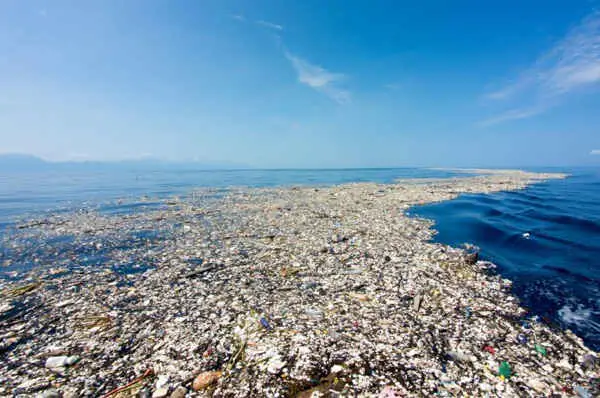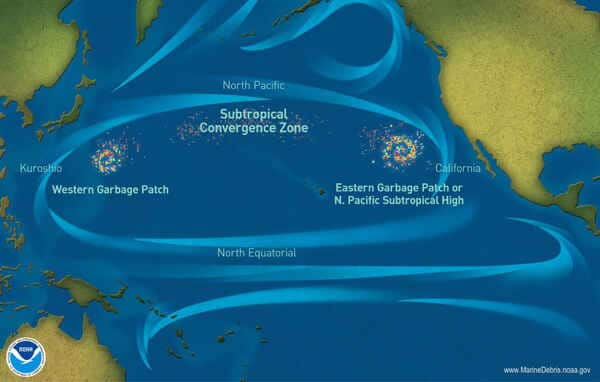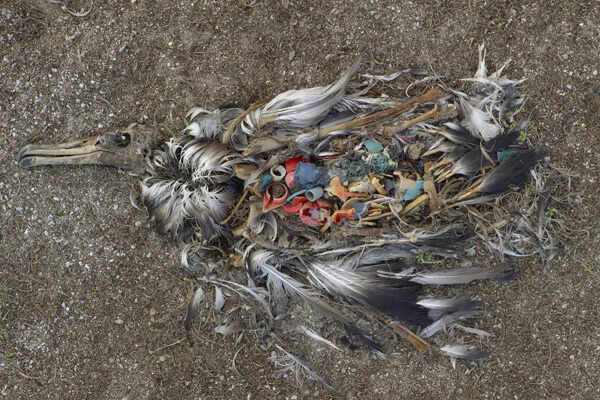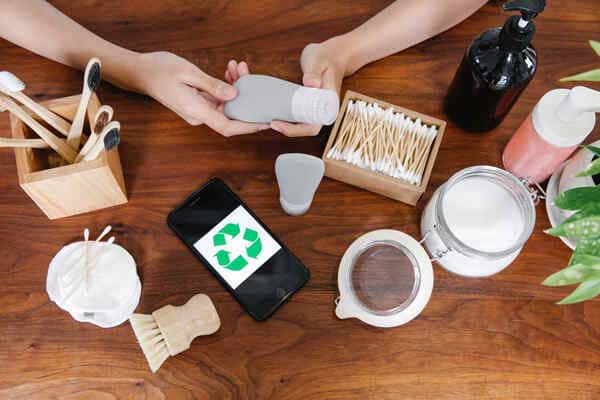How Much Plastic Waste Is Recycled, Where Do The Rest Go?
As an Amazon Associate, Ecotero earns from qualifying purchases.
Plastic is one of the most common materials we use today.
It is a convenient way to package food, pick up supplies, buy clothes, drink water, and in general, to live.
In fact, you probably have something made of plastic on you right now!
You’re probably reading this article on a cellphone or computer with plastic components.
But have you wondered what happens to the plastic you throw away?
If we’d have to guess, you might be thinking:
“Plastic wastes are recycled, right?”
Well, that is somewhat true as some plastic waste can indeed be recycled.
Unfortunately, not all trash made of plastic is recycled.
In this article, we will discuss:
- What happens to the plastic we throw;
- how much plastic waste actually gets recycled;
- what happens to plastics that aren’t recycled, and more!
Let’s get right into it.
What happens to the plastic trash we throw?
As you have guessed, some plastic trash we throw goes to the recycling facilities and will be used to create new products.
What products are created from recycled plastic trash?
Plastic is recycled into products like piping, construction materials, floor tiles, new plastic bottles, containers, and more.
Recycled plastic also makes eco-friendly clothing, sleeping bags, backpacks, toys, and carpeting materials.
However, most plastic trash is not recycled (we will discuss why below) and will never become new products.
Instead, they will end up in landfills, incinerators, or as litter on our roadsides and on the ocean.

Why can’t all plastics be recycled?
The short answer – not all plastic is recyclable.
The recycling of plastic trash is determined by two important factors: the market demand and the city government.
Demand for recyclable plastics
If there’s a demand in the market for specific post-consumer plastic waste, then recyclers and companies will recycle them.
Meanwhile, plastic trash that has no market demand (or the quality of the plastic waste is too poor or too dirty) will be sent to landfill or incinerators.
For instance, plastic bags from department stores, plastic straws, coffee cups, chips and snack packaging, candy wrappers, and soiled plastic bottles are not recyclable.
In fact, many of the common plastic products we use and throw daily aren’t recycled.
Moreover, different kinds of plastics can’t be mixed together to be recycled, and factories that make new products out of plastic trash only take specific resin types.
What are resin types, you ask?
You may have noticed that plastics have numbers ranging from 1 up to 7 on them.
(Others have letters like PLA, CPLA, and HDPE)

Each number stands for a different resin or different chemicals and materials used to create the plastic.
Different resins react differently when they are reprocessed into a new item, hence, many recycling facilities can only recycle certain types of plastic.
For instance, the plastic recycling facilities in your city might only accept #1 and #2 plastics – others will be sent to landfills.
Government regulations
Your city government regulations create market opportunities for companies to recycle plastic waste.
And since every city has different regulations and priorities, recycling some kinds of plastic might not be viable in your current location.
So before throwing away any of your plastic trash, take some time to check what kind of plastic your city actually recycles.
Otherwise, your plastic trash will just end in landfills or incinerators.
If that is the case, then it’s better if you keep those plastics at home and find other means to recycle or repurpose them.
Other reasons why plastics aren’t recycled
Besides market demand and government regulations, here are other common reasons why many plastic trash aren’t recycled:
- When plastic trash is being transported, lightweight plastics are often blown away which will eventually become litter in the environment.
- Recyclable plastic trash created in remote regions that are very far away from recycling facilities aren’t recycled as it is too expensive to ship them.
- Plastics with the same resin number can’t always be recycled together because they aren’t created with the same production method. (e.g. #2 yogurt tubs can’t be recycled together with #2 milk bottles)
- People discard plastic waste irresponsibly during travels, camping, parties, and on daily occasions.
How much plastic is actually recycled?
According to a 2017 Science Advances paper entitled “Production, Use And Fate Of All Plastics Ever Made,” only around 9% of all plastic wastes had been recycled.
Horrifying right?
Knowing that most of the plastic waste ever created by human society was not recycled!
And what’s truly heartbreaking?
It is also estimated that around 12% of all plastic waste has been incinerated (burned) which contributes to carbon emissions.
Worse, roughly 79% of the global plastic waste is currently left accumulating in either landfill or the natural environment and oceans.
How much plastic trash is in the ocean?
According to the International Union for Conservation of Nature (IUCN), at least 8 million tons of plastic waste end up in our oceans every year.
Floating plastic debris similar to the Great Pacific Garbage Patch are currently the most abundant items of marine litter found on the ocean.
The Great Pacific Garbage Patch is a collection of marine debris (most are discarded plastic industrial fishing gear) in the North Pacific Ocean.

But plastic waste isn’t just found floating on the ocean surface.
A study also revealed that microplastics and synthetic are found in the deepest part of the ocean and are ingested by deep sea creatures.
How does plastic end up in the ocean?
Commercial fishing boats leave a lot of plastic trash in the ocean, including different kinds of fishing nets and gears.
Rainwater and wind also carries mismanaged and improperly discarded plastic waste into drains, streams and rivers, which eventually find their way into the ocean.
Many people on the beach and traveling in the sea also carelessly throw all kinds of trash on the coastlines and the ocean, not thinking of the consequences of their actions.
Moreover, container ships also lose tons of cargo in the ocean every year, including plastic products, due to bad weather.
The huge amount of plastic in the ocean is resulting in over 1 million marine animals and sea birds being killed each year.

But it gets worse.
Plastic trash is eaten by fish will eventually make it to our table, and yes, into our bodies.
Suddenly, it’s not just omega-3, protein, and nutrients that our family gets from the seafood we cook for them.
There’s also plastic.
How much plastic do we eat?
According to the Thomson Reuters Foundation News, we ingest the weight of a 4×2 Lego brick in plastic in a month, and a fireman’s helmet in a year.
Reuters on the other hand suggested that we consume an average of 21 grams of plastic every month.
Meanwhile, Plastic Oceans suggests that thanks to all the plastic trash in the ocean, an average person today consumes over 40 pounds of plastic in a lifetime.
Plastic particles are not biodegradable and they can attach to human tissues causing various health problems.
Final Thoughts
With the majority of plastic waste not being recycled, it’s not hard to imagine how big of a problem this is going to become in the next few decades.
And based on what we are seeing now, it’s not hard to see how plastic pollution endangers not only the environment but also the future of human beings here on Earth.
Luckily there are many things we can all do to help protect our environment from plastic waste and make a difference.
What can you do about the problem of plastic waste?
The first step is changing how we use, recycle, and throw away plastic products.
It doesn’t have to be a sudden change that would inconvenience your (or your family’s) current lifestyle.
You can start making small changes.
For example, you can slowly switch to plastic-free and zero waste personal care products to reduce your plastic waste.

You can also join different movements on reducing plastic waste.
For instance, you can participate in the Plastic Free July challenge or support your city’s plastic waste recycling program.
As a consumer, you can influence how much plastic waste is recycled.
It all depends on how you use your plastic products and in what shape you throw them away.
And how about avoiding single-use plastic?
When shopping, take a reusable shopping bag with you and refuse a straw when you order a drink at Starbucks.
You can even bring your own reusable mug when getting beverages from stores!
Honestly, there are a number of things that you can do to help reduce plastic waste.
And while there is a lot of work to be done, saving the planet from plastic waste is not impossible.
We can all make small changes today to reduce plastic waste and protect the environment for the future generations.
References
- What Happens to All That Plastic? – Columbia Climate School
- What Happens to the Plastic We Throw Away? – National Geographic Education Blog
- 17 cool products made from recycled plastics – World Wildlife Fund (WWF)
- Why can’t all plastics be recycled? – Warwick Sanitation & Recycling
- 7 Things You Didn’t Know About Plastic (and Recycling) – National Geographic
- Production, Use And Fate Of All Plastics Ever Made
- A whopping 91% of plastic isn’t recycled – National Geographic
- Royal Statistics Society
- Marine plastics – IUCN
- Facts and figures on marine pollution – UNESCO
- What happens to all of our plastic trash once it enters the ocean? – OCEANA
- Microplastics and synthetic particles ingested by deep-sea amphipods in six of the deepest marine ecosystems on Earth
- Plastic pollution discovered at deepest point of ocean – The Guardian
- How does plastic end up in the ocean – WWF
- How does plastic end up in the ocean? – Greenpeace
- How much plastic are you eating? – Thomson Reuters Foundation
- A plateful of plastic – Reuters
- Humans Eating Plastic – Over 40 Pounds In A Lifetime
